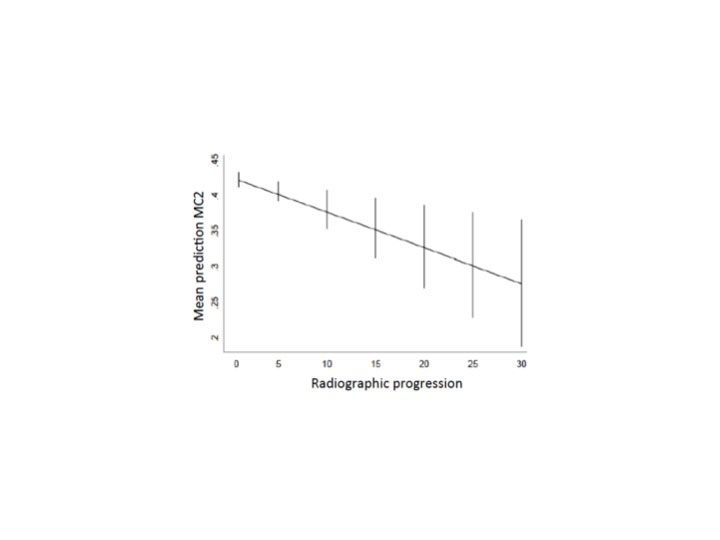Session Information
Date: Sunday, November 13, 2022
Title: Osteoporosis and Metabolic Bone Disease – Basic and Clinical Science Poster
Session Type: Poster Session C
Session Time: 1:00PM-3:00PM
Background/Purpose: Rheumatoid arthritis (RA) and osteoporosis (OP) have a complex interplay in terms of pathogenic mechanisms. In this regard, radiogrammetry (DXR) of the hand, a technique that measures the bone mineral density (BMD) at the central metacarpals (MC) , is associated with a worse prognosis in patients with RA (1). However, DXR is an expensive technique, and not very accessible in our environment. Our group demonstrated an excellent reproducibility of the MC measurement by DXA (2) and good correlation between BMD measurements obtained by DXR and DXA (3).
Objective: To evaluate if baseline BMD of the non dominant MC measured by DXA can be used as a prognostic marker, resembling DXR, in patients with early arthritis (EA).
Methods: A total of 378 subjects from the PEARL (Princesa Early Arthritis Register Longitudinal) study underwent DXA measurement of the 2nd to 4th MC’s diaphyseal area of the non dominant hand (Hologic 4500®). In PEARL sociodemographic, clinical and laboratory parameters, therapeutic data and radiographic findings are collected by protocol. Radiographic progression was evaluated in hands by a blind expert rheumatologist assessing the erosion scale of modified SvdH index in both the baseline and two year follow-up visit. To study the predictive value of MC baseline BMD by DXA, two multivariate models were fitted using generalized linear models with Stata 14.0 for Windows (Stata Corp LP, College Station, TX, USA). The dependent variables were remission (SDAI< 3.3) and radiographic progression after two 2 years of follow-up. Both models were adjusted by the classic variables that affect BMD such as age, sex and body mass index (BMI), cumulative DMARD treatment and baseline disease activity for the remission model.
Results: After adjustment by age, sex and BMI: a) those patients at remission tended to show higher baseline MC’s BMD by DXA (p=0.328); and b) those patients with higher radiographic progression had significantly lower baseline MC’s BMD as shown in Figure 1(p=0.001).
Conclusion: In our registry of patients with EA, we have detected that a lower basal BMD in the diaphysis of the central MC bones, assessed by DXA, is associated with greater radiographic progression at 2 years of follow-up after adjusting for the main factors influencing BMD. Therefore, we could conclude that a low initial bone mass could constitute a poor prognostic factor in patients with EA.
References:
1. Haugeberg G, Lodder MC, Lems WF, Uhlig T, Ørstavik RE, Dijkmans B a. C, et al. Ann Rheum Dis october 2004;63(10):1331-4.
2. Llorente I, Merino L, Escolano E, Quintanilla DM, García-Vadillo JA, González- Álvaro I, et al. C Clin J Densitom 2020;23(4):678-84
3. Ann Rheum Dis, volumen 78, supplement 2, year 2019, page A942
To cite this abstract in AMA style:
Llorente Cubas I, Fernandez Ortiz A, Garcia Vadillo J, ivorra Cortes J, Rodriguez-Rodriguez L, Garcia-Vicuña R, Castañeda S, Gonzalez I, Ortiz A. Prognostic Utility of Metacarpal Bone Mineral Density Measurement in Patients with Recent-onset Arthritis by Assessment of Radiographic Progression at 2-year Follow Up [abstract]. Arthritis Rheumatol. 2022; 74 (suppl 9). https://acrabstracts.org/abstract/prognostic-utility-of-metacarpal-bone-mineral-density-measurement-in-patients-with-recent-onset-arthritis-by-assessment-of-radiographic-progression-at-2-year-follow-up/. Accessed .« Back to ACR Convergence 2022
ACR Meeting Abstracts - https://acrabstracts.org/abstract/prognostic-utility-of-metacarpal-bone-mineral-density-measurement-in-patients-with-recent-onset-arthritis-by-assessment-of-radiographic-progression-at-2-year-follow-up/

